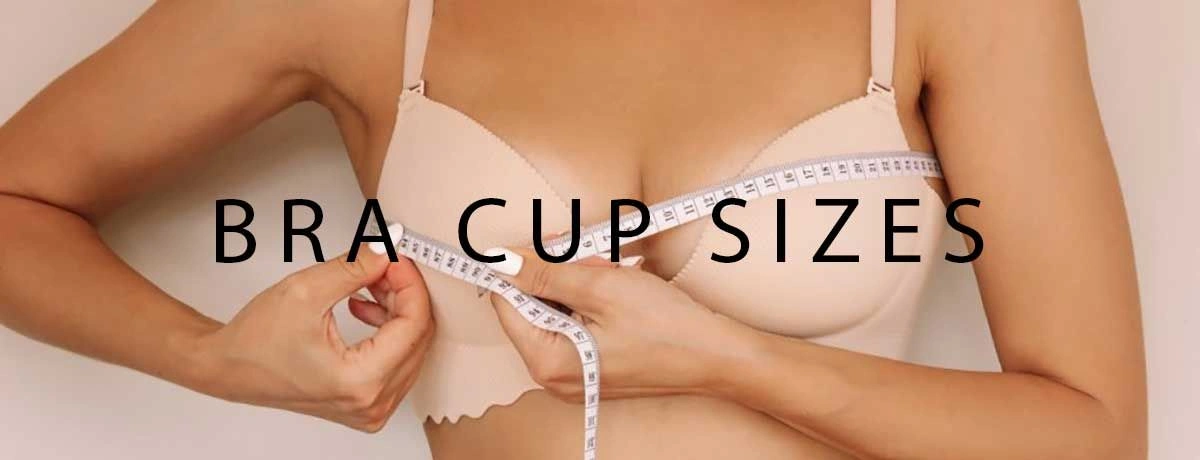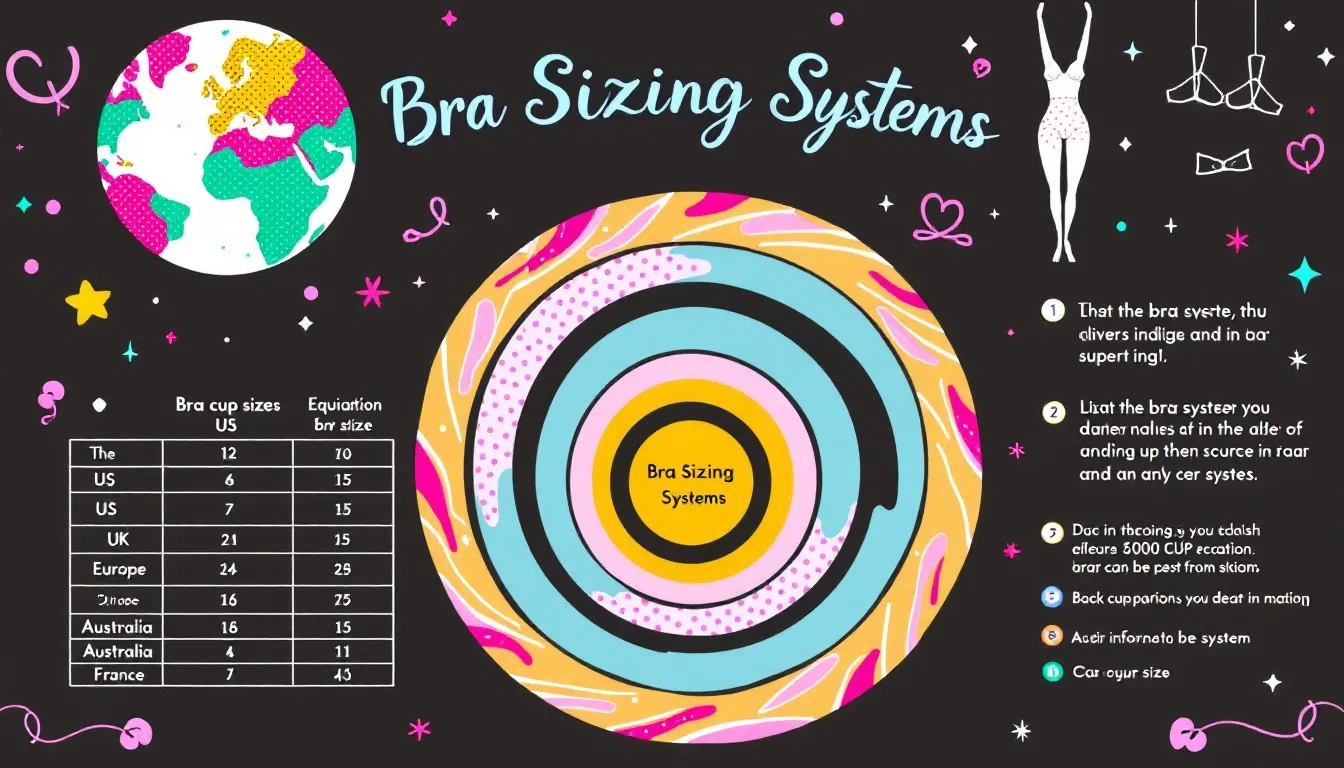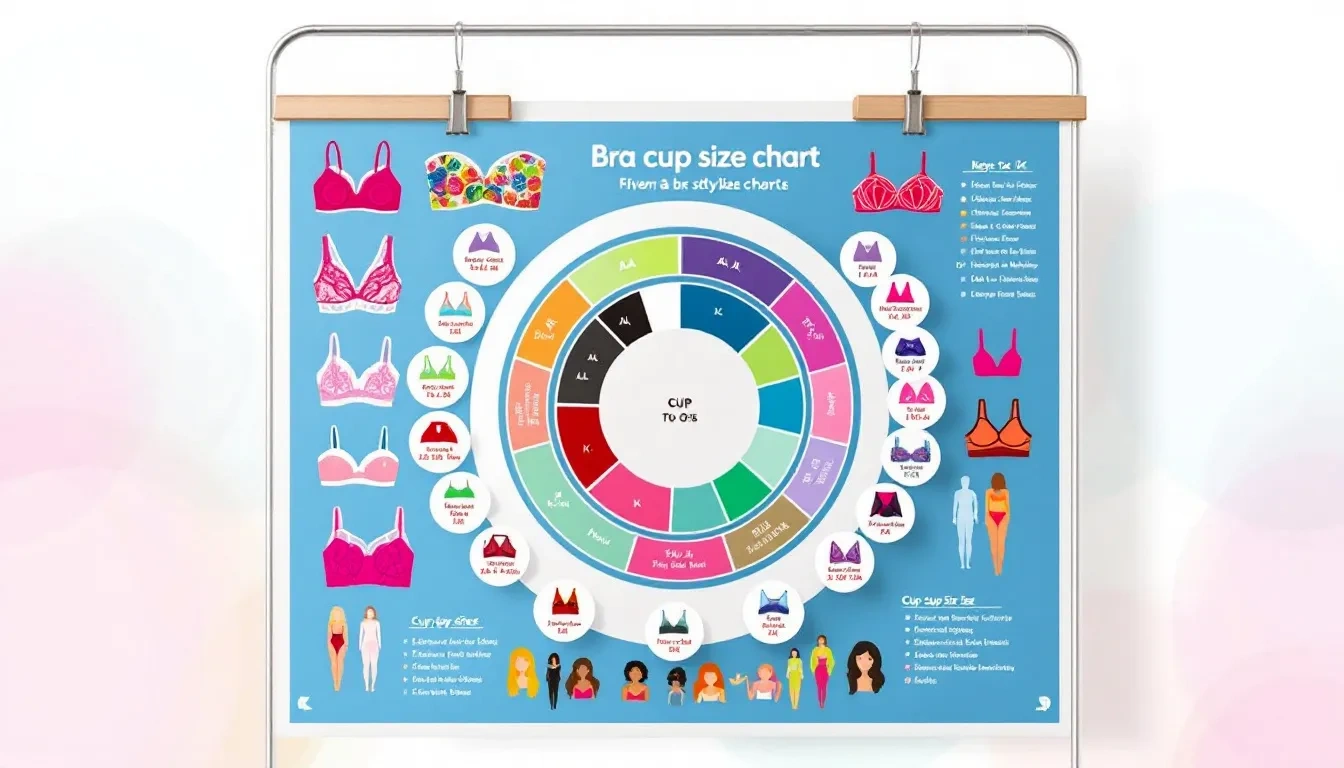
Getting the right bra cup sizes makes a world of difference in comfort and support. This guide will help you measure your size accurately and explain why each cup size matters. Say goodbye to discomfort and hello to the perfect fit.
Key Takeaways
-
Bra cup sizes range from A to F and depend on the difference between bust and underbust measurements, highlighting the importance of accurate fitting.
-
Measuring your band and bust sizes at home can guide you in selecting the correct bra size, which significantly affects comfort and support.
-
Breast shape influences the fit of a bra, necessitating an understanding of different styles and their suitability for various shapes to achieve optimal comfort.
What Are Bra Cup Sizes?
Bra cup sizes are categorized by the difference in inches between the bust and underbust measurements. The cup size depends on the difference between the bust and underbust measurements. This difference results in varied cup sizes, typically ranging from A to F, with some brands offering sizes like AA and DDD. Accurate measurements can greatly enhance comfort and support when wearing a bra.
Wearing the right bra size can prevent discomfort and issues like back pain. Keep the measuring tape parallel to the ground when measuring both bust and underbust. These measurements reveal your cup size, so accurate figures are key for a proper fit.
How to Measure Your Bra Size at Home
Measuring your bra size at home requires just a tape measure and a few minutes. You need to take two measurements: your band size and your bust size.
These will determine your bra size, helping you find a bra that offers the right support and comfort. Here’s the process.
Measuring Band Size
Wrap the tape measure snugly around your torso just beneath your breasts to measure your band size. Keep the tape measure flat and parallel to the bra band for accuracy. Add four inches to an even measurement and five inches to an odd measurement to find your band size. This method offers an approximate fit to guide you to the correct band size.
The tape measure should be snug but not restrictive around your ribcage. This ensures the bra band fits snugly and provides support without being too tight. A properly fitted band should feel secure and comfortable, lying flat against your rib cage.
Measuring Bust Size
Wrap the tape measure around the fullest part of your breasts. This helps measure your bust size accurately. Keep the tape measure level across your back for an accurate bust measurement. This measurement directly impacts the cup size you need.
The difference between your bust measurement and band size determines your cup size and band and cup sizes. Accuracy in this measurement is essential for finding the right fit. For example, if your bust measures three inches more than your band size, you would typically wear a C cup. Accurate measurements will help you find a bra that fits perfectly, offering support and comfort.
Understanding the Difference in Cup Sizes
Knowing the difference in cup sizes is key to finding a well-fitting bra. Cup sizes typically range from A through F, including variations like AA and DDD. Each cup size corresponds to a specific difference in inches between the bust and underbust.
For example, an A cup signifies a one-inch difference, while a D cup represents a four-inch difference. This knowledge helps in discovering the ideal bra fit tailored to individual needs.
A Cup vs. B Cup
A cup sizes indicate a one-inch difference between bust and band measurements, while B cups signify two inches. B cups provide more support compared to A cups. A bra cup that is too small can cause unsightly bulging of breast tissue.
Knowing these differences ensures you choose a cup that offers comfort and adequate support.
B Cup vs. C Cup
A C cup, with a three-inch difference, provides a fuller fit compared to a B cup. C cups offer more coverage and support, suitable for those needing added support.
This fuller fit enhances comfort and provides a more flattering shape.
C Cup vs. D Cup
D cups, with a four-inch difference, offer significant lift and shaping. They provide greater support and shaping compared to C cups, ideal for fuller breasts. This extra support can prevent discomfort and ensure a secure fit.
Common Issues with Bra Fit

An improper bra fit can lead to physical discomforts like back pain and shoulder strain. Common issues include underwires digging into the skin and skin irritations from poorly fitted bras. A correctly sized band should feel snug and provide support without being too tight.
To maintain effectiveness, tighten the straps regularly and replace bras every six months if worn frequently. Addressing these issues can significantly improve your comfort and bra-wearing experience, especially if straps dig.
Too Small a Cup
Signs of a too-small cup include overflowing breast tissue, discomfort, poking underwires, and a center panel that won’t lie flat. A too-small cup size can lead to skin irritation and rashes. About 84% of women underestimate their cup size, leading to these issues.
A common mistake is choosing a back band that’s too large and a cup that’s too small. If your bra consistently needs adjustment or causes discomfort, consider getting a new fitting. Correct cup sizing can prevent these problems and improve your overall bra fit.
Too Large a Band
A bra band that is too large often rides up the back. A too-large band reduces breast support, leading to discomfort and inadequate support.
About 76% of women have overestimated their band size. Accurate band sizing provides better support and prevents the band from riding up, enhancing overall fit.
The Impact of Breast Shape on Bra Fit
Breast shape significantly influences bra fit, as some shapes may need specific styles for better accommodation. For example, women with a ‘Low Profile’ shape might find structured bras gap, preferring unstructured styles like bralettes. The ‘Side Set’ shape often causes gaping in the front, needing styles like demi-cuts or push-ups for a better fit.
Those with a ‘Relaxed’ shape should choose bras with structured cups to minimize gaping and ensure comfort. Women with a ‘Bell’ shape may see gaping at the top of cups and benefit from lower necklines and padded bras.
Understanding your breast shape and selecting the right properly fitted bra fits style can greatly improve fit and comfort.
The Role of Sister Sizes
Knowing sister sizes can help find a suitable bra fit when standard sizes don’t work. Sister sizes offer an alternative for a better overall fit when the standard size is hard to find.
To find a sister size, go down a band size and up a cup size, or vice versa, keeping the same cup volume. This flexibility is useful when a specific size is unavailable, ensuring a comfortable and supportive fit.
International Bra Sizing Differences

Bra sizing varies significantly across countries, often confusing consumers.
Here are some key differences:
-
In the US, band size is measured in inches.
-
In Europe, band size is measured in centimeters.
-
French and Spanish band sizes are usually 15 cm larger than standard European sizes.
In Australia, bra sizes increase by 2 cm for each cup size. The US and Australian sizing systems differ for H-cup sizes. Knowing these differences helps find the right fit when shopping internationally.
Finding the Perfect Bra Style

Finding the perfect bra style requires understanding your breast shape and its influence on bra choice. East-West breast shapes suit full cup bras with side support or plunge styles that bring the breasts together. Side-set breasts need balcony bras with vertical seams, strong side support, or plunges for cleavage.
Round breasts can wear full cup bras or plunges, depending on whether they want to de-emphasize or enhance shape. Asymmetric breasts benefit from bras with stretch or molded cups, and silicone boosters can help balance appearance. Knowing your breast shape and the best styles for it helps find the perfect bra fit.
Summary
Understanding your bra size and fit is crucial for comfort and support. Accurate measurements of your band and bust size can help you find the right cup size, and recognizing common fit issues can prevent discomfort. Knowing how breast shape affects bra fit and the concept of sister sizes can further refine your search for the perfect bra. Ultimately, a well-fitted bra can enhance both your comfort and confidence.
Frequently Asked Questions
What is the cup on a bra?
The cups on a bra are designed to cover and support the breasts, providing proper encasement and hold. Proper fitting is crucial; loose cups may cause sagging, while tight cups can result in discomfort and skin marks.
Which cup size is bigger, B or C or D?
The cup size increases with each letter, so size D is larger than both B and C. In summary, D is the biggest among the three sizes mentioned.
How do I measure my band size?
To accurately measure your band size, wrap a tape measure snugly around your torso beneath your breasts and ensure it is flat. Add four inches to an even measurement or five inches to an odd measurement to determine your band size.
What is the significance of sister sizes?
Understanding sister sizes is significant as it provides an alternative fitting option, enabling one to adjust band and cup sizes without altering the overall cup volume, ensuring better comfort and support.
How does breast shape affect bra fit?
Breast shape significantly influences bra fit, as certain shapes may necessitate specific styles, such as strong side support for side-set breasts, to achieve optimal comfort and support. Hence, selecting the appropriate bra style is essential for a proper fit.
